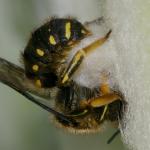Apis maculata FABRICIUS 1781; Apis fulvipes VILLERS 1789; Apis modesta CHRIST 1791; Apis amoenita CHRIST 1791; Apis uncata SCHRANK 1802; Anthidium marginatum LATREILLE 1809; Anthidium obtusatum LEPELETIER 1841; Anthidium nigrithorax DALLA TORRE 1877; Anthidium fasciatum SCHIRMER 1915; Anthidium pervigil (HARRIS 1776[Apis])
Males of this strikingly-coloured, medium-sized bee hover and dart around patches of flowering labiates (and some other flowers) and regularly pursue other insects.
Widely distributed throughout much of southern England and Wales, becoming scarcer in the north. Note the three Scottish records, all in Dumfries and Galloway. It is also found on the Channel Islands and on the Isles of Scilly (St Mary's). There are no records from Ireland. Recently (since about 1993) the bee has become locally common in many sites in southern England after a long period of scarcity. This species is certainly under-recorded in Britain.
This species is not regarded as being threatened.
Varied, including private gardens (both in rural and urban areas), open broadleaved woodland, chalk grassland, coastal sand dunes and landslips.
Single-brooded; from late May to early August, with a peak in June/July. In 1995 both sexes in freshly emerged condition were noted in late July; it is not known if these represented a partial second brood, or a single, staggered emergence.
Large males vigorously defend clumps of favoured flowers and will intercept and chase away any other insect which enters such a territory. Males have even been known to kill such intruders (by crushing them between the ventral surfaces of the flexed down abdomen and the thorax). Females are allowed to visit the flowers and it is at these sites that mating takes place. Resource defence polygyny, as this behaviour is called, is discussed by Severinghaus, Kurtac and Eickwort (1981) and is summarised by Thomhill and Alcock (1983). Females select existing cavities as nest sites, examples including insect exit burrows in dead wood, hollow stems, crevices in the mortar joints of masonry, burrows in the soil, and various man-made objects. The cell walls and closing plug of the nest are fashioned from compacted layers of long, silky hairs which are shaved off leaves by the female's multi-dentate mandibles. Favoured plants are woundworts (Stachys lanata [s. byzantina]), yarrow (Achillea millefolium), great mullein (Verbascum thapsus), Pelargonium, cotton thistle (Onopordum acanthium) and house-leek (Sempervivum). Hairs are brought to the nest site in a ball and applied to the inner surface of the cavity by teasing them out with the mandibles; the gaster is then used to tamp down the hairs (A Raw, pers. comm.). The species has earned the colloquial name 'wool-carder bee' from this habit.
The bees visit a wide variety of flowers.
The bee Stelis punctulatissima is a cleptoparasite of A. manicatum.
1998
Proofed: January 2012










